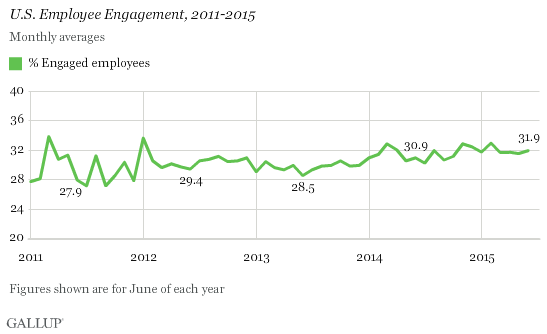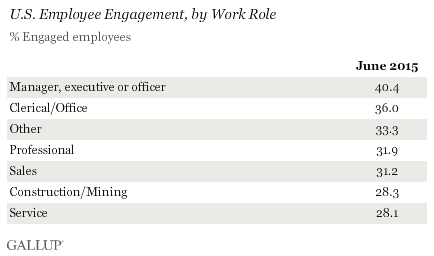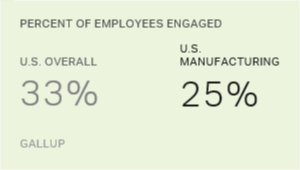Story Highlights
- U.S. employee engagement stagnant in 2015
- Employee engagement remains above 2011-2013 levels
- Managers most engaged role in workplace
WASHINGTON, D.C. -- In June, the percentage of U.S. workers engaged in their jobs continued to hold steady at 31.9%. The latest monthly average is consistent with readings for much of the year. With the exception of February, employee engagement figures for the first six months of 2015 have steadily hovered between 31.5% and 31.9%. But engagement remains higher than it was in 2011-2013.

The June 2015 estimate is based on Gallup Daily tracking interviews conducted with 6,637 adults working for an employer. Gallup categorizes workers as "engaged" based on their ratings of key workplace elements that predict important organizational performance outcomes. Engaged employees are involved in, enthusiastic about and committed to their work. Gallup's extensive research shows that employee engagement is strongly connected to business outcomes essential to an organization's financial success, such as productivity, profitability and customer engagement. Engaged employees drive the innovation, growth and revenue that their companies need.
Managers Still Most Engaged Work Role
Worker engagement varies by job type, and Gallup has consistently found managers, executives and officers to be the most engaged workers. In June, 40.4% of those performing in these roles were engaged, placing them far ahead of the national average and every other work role. Clerical/office workers were the second-most engaged group of employees, at 36%, while construction/mining workers (28.3%) and service workers (28.1%) were the least engaged groups.

Bottom Line
While U.S. employee engagement has been stable in 2015, it is higher than it was from 2011 to 2013. It could be that the more positive U.S. employment situation is contributing to worker engagement. Gallup has previously found that improvements in engagement coincide with improvements in unemployment and underemployment.
While economic conditions can help explain employee engagement readings to some degree, Gallup has found that engagement is tied to many factors -- managers being chief among them. Gallup research shows that a manager's engagement -- or lack thereof -- affects his or her employees' engagement, creating a "cascade effect." Essentially, employees' engagement is directly influenced by their managers' engagement -- whose engagement is directly influenced by their managers' engagement.
Although managers represent the most engaged workgroup in the U.S., nearly 60% of this group is not engaged or is actively disengaged. Managers' lack of engagement may be at least somewhat responsible for their employees' same lack of engagement. If the nation's employers can continue to raise the levels of engagement among their leaders and managers, they finally may be able to accelerate their overall levels of employee engagement.
Survey Methods
Results for this Gallup poll are based on telephone interviews conducted June 1-30, 2015, on the Gallup Daily tracking survey, with a random sample of 6,637 employed adults, aged 18 and older, living in all 50 U.S. states and the District of Columbia. For results based on the total sample of employed adults, the margin of sampling error is ±3 percentage points at the 95% confidence level. All reported margins of sampling error include computed design effects for weighting.
Each sample of employed adults includes a minimum quota of 50% cellphone respondents and 50% landline respondents, with additional minimum quotas by time zone within region. Landline and cellular telephone numbers are selected using random-digit-dial methods.
Learn more about how Gallup Daily tracking works.


